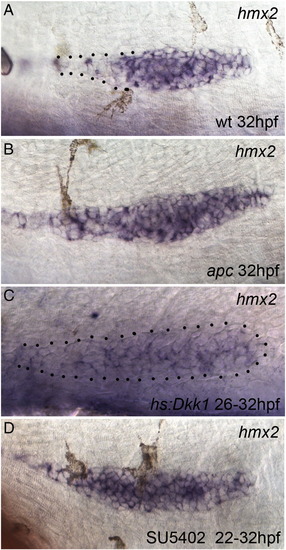Fig. S1
|
hmx2 and hmx3 are required but not sufficient to induce proliferation in the primordium. (A) In wt embryos hmx2 is expressed broadly in the leading portion of the primordium but is reduced in the trailing region. hmx3 expression is identical (not shown). (B) In apc mutant embryos, in which the Fgf and the Wnt/β-catenin pathways are upregulated, hmx2 is uniformly expressed in all cells of the primordium suggesting that these genes might be regulated by these pathways. (C) Reducing Wnt/β-catenin signaling by heatshock induction of dkk1 in Tg(hs:Dkk1) embryos leads to a downregulation of hmx2 demonstrating that Wnt/β-catenin signaling is an important regulator of hmx2 expression. (D) On the other hand, treatment with the Fgfr1 inhibitor SU5402 revealed that the Fgf pathway does not regulate hmx2 and hmx3 expression, as previously described (Feng and Xu, 2010). In SU5402 treated embryos hmx2 expression is ubiquitously strong, as Wnt/β-catenin is upregulated in these primordia. Even though hmx2 is expressed, SU5402 treated primordia do not proliferate demonstrating that hmx2 and hmx3 are not sufficient to induce proliferation in the absence of other Fgf dependent factors. |
| Gene: | |
|---|---|
| Fish: | |
| Conditions: | |
| Anatomical Term: | |
| Stage Range: | 20-25 somites to Day 4 |
Reprinted from Developmental Biology, 349(2), Aman, A., Nguyen, M., and Piotrowski, T., Wnt/β-catenin dependent cell proliferation underlies segmented lateral line morphogenesis, 470-482, Copyright (2011) with permission from Elsevier. Full text @ Dev. Biol.

